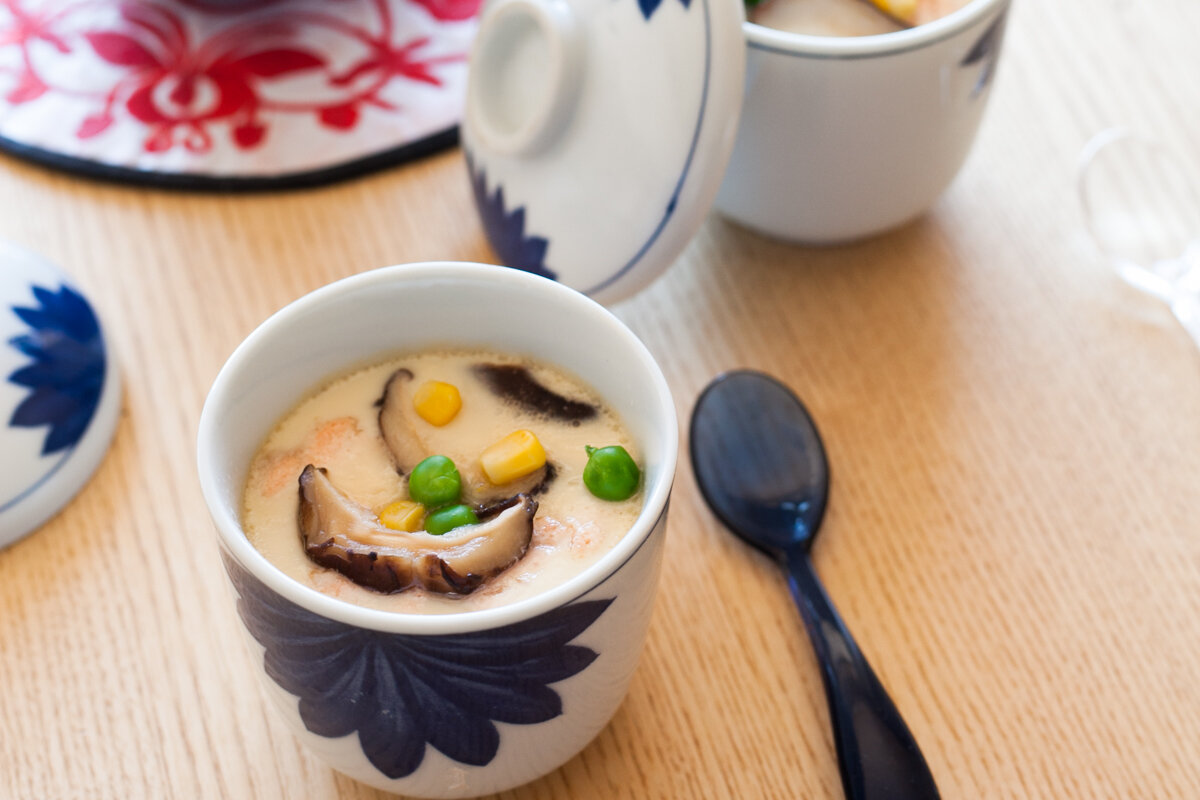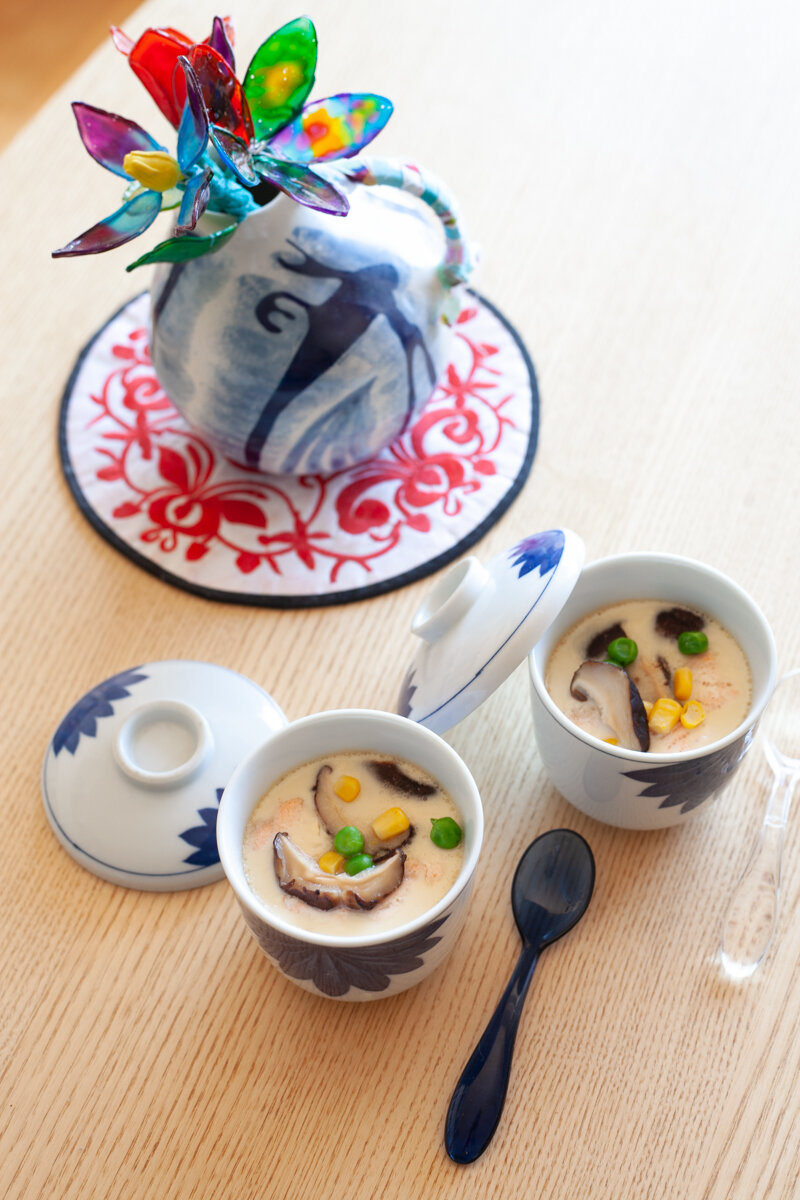Steamed Egg that is silky and smooth with a hint of umami flavor served in chawanmushi cups.
I came back from visitng my folks in Taiwan a few months ago with these chawanmushi cups securely wrapped in my carry-on. I was bringing back to France a piece of my childhood. These cups are just about as old as I am and that’s counting at least a few decades old.
Chawanmushi iliterally translated from Japanese is comprised of two words: teacup and steam. These cups are specifically used for this Japanese delicacy. It holds a celestial silky, steamed dashi egg mixutre that is just a palate pleaser for those who like a hint of umami in their lives.
I grew up with these ceramic cups.
My mum’s daily cooking duties were relinquished once retirement arrived but her cooking activies had already been reduced once my sister and I moved away from home. Those empty stomachs she once fed are now living abroad and salivating in retrospect of her cooking. I’m happy to see retirement suits her well and she’s happy to pass on remnants of her ceramics collection to anyone who will use them.
These are days of confinement as France goes into its eleventh day of lockdown. I am back to making meals 2-3 times a day and find myself bouncing between concocting a quick fix from the fridge or really taking my time to make something with meaning. So this is one of those meaningful recipes, to me at least.
Steamed Egg that is silky and smooth with a hint of umami flavor.
Mum used to make chawanmushi for breakfast, sometimes a much simpler version without all the optional fillings I listed in the recipe. When I reflect back to my childhood I think about all the love that went into those meals, the fragrant aroma of what’s cooking, and the morning hours she had to rise to in order to get those power meals on the table for us to start our day right, I find myself doing the same now but on a subpar level. Meals were not just deliciously served but aesthetically presented.
I don’t own all the pretty dishes like we had when growing up, especially dishware meant specifically to serve or to cook just one thing. If this seems like a frivolous purchase to you buying a set of chawanmushi cups for something you’ll make or try to make once a year you can certainly use ramekins or any heatproof tea cups you have in the house.
Owning these cups gave me the incentive to make this appetizing side dish and it brought me gratification to see my kids and husband tasting it out of the same chawanmushi cups I ate out of while growing up with my parents.
Chawanmushi
INGREDIENTS//Yields 4 servings
• 3 eggs
• 300 ml dashi
• 1 teasppon soy sauce
• 1 teaspoon mirin
• 1/2 teaspoon salt
PREPARATION
Rehydrate the shitake mushrooms if you are using dried ones.
Soak the konbu for the dashi stock. Pre-cook, steam or blanch certain vegetable fillings that take longer to cook such as carrots, edamame beans, gingko nuts.
Fillings
• 80 grams of seafood, or poultry, cut up in small pieces (scallops and salmon work well)
• 20 edamame beans or peas
• 2 shitake mushrooms
• 2 tablespoon corn kernels
• Sliced carrots, gingko beans, and naruto (fishcakes) are used as tradtional garnishes.
INSTRUCTIONS
Crack the eggs into a mixing bowl and whisk it by hand. Then whisk in the dashi stock, soy sauce and mirin.
Be careful not to overbeat it.
Take a sieve and strain the mixture into a bowl or large measuring cup.
Divide your choice of fillings and place them into the bottom of the teacup.
Pour the mixture into the 4 cups equally.
Cover each cup with aluminum foil.
If you don’t have a steamer, in a large pot (enough to hold and cover your teacups) place the bottom of a bamboo steamer or a metal steamer rack inside and add an inch and a half of water. Bring it to a boil on high heat.
Then carefully place your heatproof cups into the pot and steam for 8-10 minutes.
At this point carefully take out the cups (be careful, it’s hot! I wear kitchen mittens), uncover them, and add your garnishes so that they float at the top ( I added more corn kernals and mushroom slices in the photos shown) .
Recover the cups with the aluminum, reduce the heat, put the cups back into the steamer and continue to steam for another 15 minutes (approximately 25 minnutes altogether).
Take your cooked chawanmushi out of the steamer carefully and cover with the individual lids to set or just keep the aluminum on for another couple of minutes.
If you have the chawanmuwhi cups serve it with the lid so that the individual can uncover their heavenly surprise.
NOTE
If using edamame, peas, and carrots as choices for your vegetable filling I like to pre-steam them beforehand halfway into fully cooking through. Then, take them out and put it on the side until you add them into the recipe.
You can use ramakins if you don’t have teacups.







